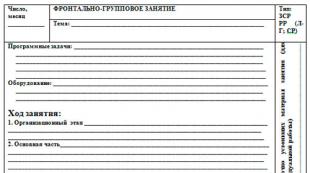Basic level of English proficiency: from zero to A2. Berlitz English Basic Course How it works
My English teacher always asked students in the first lesson: “For what purpose do you need a foreign language? If for the profession of an interpreter, get ready to enter the philological faculty. And for elementary communication just learn 850 basic words and a few grammar rules.”
Basic English
Skeptics will be surprised, but this scheme works! And its advantage is that you can master the minimum vocabulary in just a month. Do not believe? Today there is a unique opportunity to test the theory on your own experience. Editorial "So simple!" prepared for you those same 850 words, which are quite enough to communicate with a resident of any English-speaking country.
To master the basic vocabulary, do not be lazy and study every day. Be sure to consolidate knowledge in practice, for these purposes any person who agrees to examine you is suitable.
 ©DepositPhotos
©DepositPhotos
For more convenience words are grouped: objects and phenomena (600 words, of which 400 are common, and 200 are designations of objects); actions and movements (100 words); expression of quality (150 words, of which 100 are common and 50 have an opposite meaning). Each group is shown in the picture. Save and learn now!
850 words for basic English
- Objects and phenomena (designation of objects)
If you studied English at school, most of these words are probably familiar to you. Don't try to learn everything at once, learn alphabetically. First, read the words with translation 2-3 times a day. In a week it will turn out that you know 80% of them.





- Objects and phenomena (general)
To better remember words, be sure to speak them out loud. In your free time, on a walk or in transport, try to mentally name the objects around you in English. It would be great if someone checked your knowledge 1-2 times a week.









- Actions or movements
This list includes basic english words, not only verbs, but also pronouns, prepositions and polite phrases. You can learn in any order, or draw diagrams with arrows indicating movement or movement.
- Expression of quality (general)
Adjectives saturate the language so that it is not too formal. Help improve memory next exercise: Take any object or picture and describe it with adjectives. The more words you use, the better.


- Quality expression (with opposite meaning)
For a better memorization of adjectives with the opposite meaning, do the previous exercise with a description of the subject using antonyms. You can do it differently: write down the word, and through a hyphen - its opposite meaning.
With this basic vocabulary, you can safely go on a trip! And in order to better understand the English language and learn how to put the necessary words into sentences, which takes into account the coordination of tenses.
Experts say that. The most important thing is desire, patience and perseverance. Do not quit classes after a week, study, be sure to practice speaking, read English texts, watch films without translation, and everything will work out. I wish you success in learning English!
Write to us in the comments how you or your friends managed to quickly learn. And don't forget to share this helpful article with your friends on social media.
Alexandra Dyachenko is perhaps the most active editor of our team. She is an active mother of two children, a tireless hostess, and Sasha also has an interesting hobby: she loves to make impressive decorations and decorate children's parties. The energy of this man cannot be put into words! Dreams of visiting the Brazilian carnival. Sasha's favorite book is "Wonderland Without Brakes" by Haruki Murakami.
( "proleed_data_link" : "https://www.proleed.ru/loadads.jsp?partner=naweb808a5&adscount=3&mainfilter=ENGLISH&secfilter=", "proleed_block_type" : "horizontal", "proleed_title_size" : 16, "proleed_title_color" : "# 0000cb", "proleed_message_size" : 14, "proleed_message_color": "#000000", "proleed_partner_size" : 14, "proleed_partner_color": "#006500" )
How to say Hello
The conversation begins with a greeting, and we will begin our acquaintance with this basic course with it. Greetings (greeting) is an important part of the dialogue. Greeting with a certain phrase and intonation of acquaintances and close people, we show our mood, and when we meet new people, it is during the greeting that the first impression is made of us.
As in Russian, in English there are many options for greeting, which must be chosen depending on the situation and time of day.
It is worth immediately recalling the famous Hollywood smile, which must accompany all greeting phrases. Even if you don't feel like smiling at all, remember that in English-speaking countries, smiling is accepted and is an indicator of good manners.
So, the universal phrases for greeting are " hello» – Hello, « Hi» – Hello- more relaxed, but less common, as well as " good morning/afternoon/evening» – good morning / afternoon / evening. When using the times of day in a greeting, it is worth considering some nuances: morning- before noon, noon- until 6 p.m. evening- until midnight. It must also be remembered that " good night» – Good night And " good day» – Have a good day- more related to the words of farewell.
Most likely, the given universal phrases are well known to everyone and do not need a detailed description and a long study. In order to diversify the vocabulary in terms of greeting expressions, we will give examples of some more interesting shapes politeness and ways to say hello.
Hey, how are you doing? –Hi, how are you?
What's up? – What's new / How are you?
It is good to see you! – I'm glad to see you!
Such phrases are suitable for informal communication. Although the expression "Hi, how are you?" sounds rather boring and primitive, but English-speaking interlocutors will like it, because it sounds less formal than “ hello”, and shows your interest.
- Hi! How are you doing?
– Fine, thanks. And you?
- Hello! How are you?
- Excellent thank you. And you?
- Fine.
When communicating with unfamiliar people or in business circles, you can use the phrases:
– Good to meet you or It is nice to meet you –Nice to meet you.
Hello, isn't it a lovely day? – Hello, great day, isn't it?
Concluding the topic of greetings, I would like to recall the good old form " How do you do”, which is often used by our compatriots as“ Hello!". So, it has long been outdated and is rarely used in England and America, and can even make the Anglo-Saxons perplexed.
In this topic, it is also necessary to raise another important issue - how to address people whose name we do not know? Along with the universal Excuse me» – Sorry, … there are other ways to address a specific person. The most common forms are Mr.(Mister), Mrs. (Mrs.), Ms.(Miss- for a young girl or unmarried woman), a surname is added to them. If you don't know the last name of the person you're addressing, use Sir, madam or Miss.
Since these forms of address are quite specific and assume that you know the gender, age, and even the marital status of the interlocutor, you can protect yourself from making mistakes when addressing by asking the question: What should I call you? – What should I call you? If you yourself hear such a question, you should answer Please call me […] – Please call me[Name].
Having learned to greet the interlocutor and address him, let's analyze one of the most important and necessary verbs in the English language - the verb " to be". It is with him that you need to start learning English grammar. Verbs in English do not change by person, but the verb to be- exception. In English, you can't just say "I'm beautiful", "He's weird", "They're at home", "You're at work". Any foreigner will say: “I am beautiful”, “she is strange”, “they are at home”, “you are at work”. This is the nature of the language.
Consider the forms of the verb to be and the main personal pronouns. In the present tense, the verb to be has three forms: AM, IS, ARE.
I am – I am
He / She / It is - he, she, it is
We are –we are
You are – you, you are
They are – they are
At this stage, it is important to understand that to be And AM, IS, And ARE- these are not 4 different verbs, but forms of the same verb to be.
This verb can be either an independent semantic unit or an auxiliary linking verb. Consider two examples:
1) - The book is on the table. Book – book, table – table. The whole sentence will be translated as follows: The book is on the table. Here is the verb form to be – IS plays the role of an independent verb and is translated by the word " lies". Literal translation - the book is on the table.
2) - I am a doctor. Doctor – doctor. I am a doctor (I am a doctor). In this example, the verb form to be – ARE plays the role of a linking verb in the meaning of " There is". Unlike Russian, in English the linking verb is never omitted, because English sentence has a strictly fixed word order: subject (subject) + predicate(verb) + addition (object). In such cases, the linking verb is not translated into Russian.
In writing, you can often see abbreviated forms of the verb to be, where the first letter of the verb is abbreviated and written with an apostrophe. Abbreviations are also pronounced a little differently than full combinations:
I am = I'm
We are = we're
He is/ She is = he's/she's
At the end of the lesson, consider a short dialogue in which greeting forms and the verb to be.
– Hello! I am Boris.
Hi Boris! I am Mary.
How are you, Mary?
– I am fine, thank you. And you?
– I am OK, thanks.
Are you American, Boris?
– No, I am Russian. And you?
- I'm American.
Hello, my name is Boris.
Hello Boris, my name is Mary.
How are you, Mary?
- OK, thank you. And you?
- I'm fine, thank you.
Are you an American, Boris?
- No, I'm Russian. And you?
– I am an American.

Berlitz (Berlitz) English language basic course
If you want to quickly master spoken English, then the Berlitz course is just what the doctor ordered. The main task of Berlitz is to make you speak the language you are learning from the first lesson. The basic Berlitz course includes 12 lessons with a consistent presentation of material, from simple to more complex and repetition in new lessons of grammar and vocabulary already covered. You do not need to learn grammar rules and structures, but they are included in the textbook for reference. You learn to speak English right away and at the same time learn grammar by induction. Each lesson consists of a dialogue on the most popular topics, comments and exercises. You can proceed to the next lesson only after completing the exercises completely and making no more than 5 mistakes. Otherwise, it is better to repeat the lesson passed once again. After spending some time and effort, you can easily communicate on the most popular topics.
The Berlitz method has already helped millions of users around the world to start speaking new languages. In addition to the course "Berlitz English language Basic Course” the company offers courses in many other languages, the most popular courses are French and Spanish.
Whether you want to spruce up your resume, prepare for a trip abroad, or have your own personal reasons for learning a language, a Berlitz course will help you reach your goals. The method is based on listening to materials and developing conversational skills. This is the most natural way to learn a new language. Even beginners will be able to start saying simple sentences after the first lessons. This method, presented to the public back in 1878, revolutionized the study of foreign languages. Today, the effectiveness of the Berlitz technique has been scientifically proven and is the standard in the study of foreign languages.
Berlitz is the world market leader in language learning and has made its mark in more than 70 countries worldwide. For more than a century, the Berlitz company has enabled its clients to communicate confidently in foreign languages, be successful in building a career and achieve their goals.
When Maximilian Berlitz introduced his revolutionary method to the US in 1878, he changed the world of language learning forever. Based on immersion in the language environment through the use of speakers and teachers of native speakers and a focus on conversational communication, the Berlitz method allows you to accelerate the learning process and lay a solid foundation for effective communication, which is self-confidence. In the future, the method was repeatedly replicated by other schools. For example, known to many in our country, as well as “” and “
Basic English course Ter-Minasova S.G. intended for the general public and, in particular, for students of higher educational institutions. The course will be useful primarily to those who wish to receive short term high-quality basic knowledge of English grammar and skills of oral and written speech. Inside you will find interesting texts, dialogues and exercises, as well as a large amount of regional information. The book consists of 20 lessons, built according to the principle from simple to complex. This textbook is intended for students of both English learners and non-linguistic universities, as well as for everyone who studies English at school, in courses and on their own or who wants to improve their knowledge. (CD included with print edition only.)
Year: 2016
Publisher: lingua
Ter-Minasova S.G., Kostyukova K.S., Pavlovskaya O.A.
Format: pdf
Textbook
Download tutorial + audio CD
Size: 162 MB.
diphthongs
The presence of diphthongs is a feature of the English language compared to Russian. Diphthongs are vowels made up of two elements. Both elements of a diphthong make up a single sound. However, when pronouncing diphthongs, the main stress falls on the first element. Then there is a movement of the speech organs to the second vowel element. The second element of the diphthong is incomplete and very fluent, and differs in strength from the corresponding isolated vowels. Diphthong, thus pronounced as one indivisible vowel with a sliding pronunciation.
Contents
Preface 4
How to work with this book 5
INTRODUCTORY PHONETIC COURSE
LESSON 1 (UNIT 1) 10
§1. English alphabet 10
§2. Transcription marks 11
LESSON 2 (UNIT 2) 20
§1. Open and closed syllables 20
§2. Pronunciation of individual letters and sounds 21
§3. Letter combinations 24
LESSON 3 (UNIT 3) 28
§1. Vowels and sounds 28
§2. Diphthongs 30
LESSON 4 (UNIT 4) 34
§ 1. Emphasis 34
§2. Intonation 37
MAIN COURSE
LESSON 5 (UNIT 5) 46
§ 1. Personal pronouns 47
§2. Personal pronouns and possessive adjectives. . .48
§3. Verbs to be (to be), to do (to do), to have (to have) 49
§4. Articles 51
LESSON 6 (UNIT 6) 58
§1. What time is it now? (What time is it now?) 59
§2. Cardinal and ordinal numbers 60
§3. Present Simple (Present Simple) 63
§4. Demonstrative pronouns 76
LESSON 7 (UNIT 7) 80
§ 1. Degrees of comparison of adjectives 83
§ 2. Simple past tense (Past Simple) 85
§ 3. Verbs to do, to make 93
LESSON 8 (UNIT 8) 96
§ 1. Pronouns somebody, anybody, nobody 98
§ 2. Prepositions 101
§ 3. Present and Past Continuous (Present Continuous, Past Continuous) 108
§ 4. "Tail" questions (Tag questions) 114









